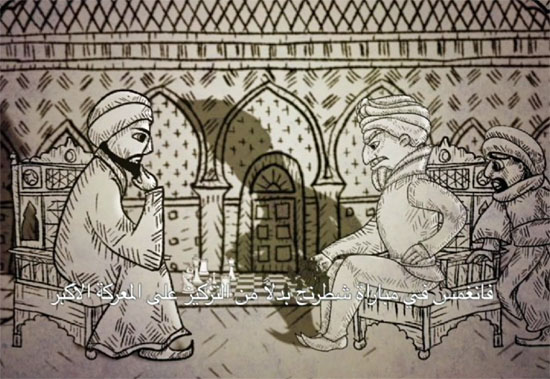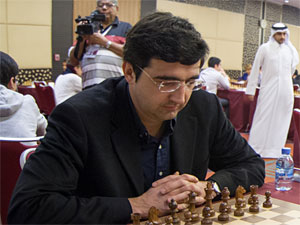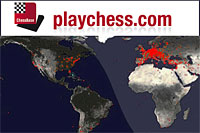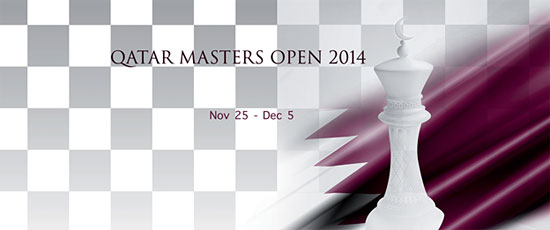
The Qatar Masters Open 2014 is being held from November 25 to December 5 at the Crowne Plaza Hotel in Doha, Qatar. There are 92 grandmasters participating, or 60% of the 154 total players. 56 GMs are over rated 2600, and an incredible 14 over 2700. Let those numbers sink in for a moment! This tournament truly is a convention of brilliant chess minds.
Kramnik wins, takes the sole lead
By Sagar Shah
After his loss to Kramnik in the seventh round, Giri was on the backfoot. He was now joined by Vladimir on the top, and while Kramnik faced Salem Saleh in the eighth round, Anish was paired against the super strong Chinese Yu Yangyi. And sure enough the Chinese player came out all guns blazing!

Can you see it in his face? Anish Giri, with the white pieces, does not look exactly set to win

[Event "Qatar Masters Open 2014"] [Site "Doha QAT"] [Date "2014.12.03"] [Round "8.1"] [White "Giri, Anish"] [Black "Yu, Yangyi"] [Result "0-1"] [ECO "D38"] [WhiteElo "2776"] [BlackElo "2705"] [Annotator "Sagar Shah"] [PlyCount "182"] [EventDate "2014.11.26"] 1. d4 Nf6 2. c4 e6 3. Nf3 d5 4. Nc3 Bb4 {The Ragozin variation has become one of the mainstay openings at the top. The fact that it is complex makes it interesting to play from both sides.} 5. cxd5 exd5 6. Bg5 h6 7. Bh4 (7. Bxf6 Qxf6 8. Qb3 {is the quieter way to play.}) 7... c5 {I have always like this move by Black. It is as if he doesn't care about the positional features. All that he wants is a sharp and dynamic game.} 8. e3 (8. dxc5 Nbd7 9. e3 Qa5 10. Rc1 Ne4 {was how Vishy Anand beat Vallejo Pons in Bilbao 2014.}) 8... c4 { Taking away the natural d3 square from the bishop.} 9. Be2 Bf5 {With this move Black takes control of the h7-b1 diagonal. This move has not been very popular and the two games where it was tried by good black players Palac and Aleksandrov ended in a loss for them. Yet Yangyi plays it. It seems he has come with some fresh analysis.} (9... g5 {was the main move.}) 10. O-O Bxc3 $5 {The moment White castled and the pin no longer existed on the knight, Black takes on c3. This is very concrete play by Yu Yangyi.} 11. bxc3 O-O 12. Rc1 { b-file was open but Rb1 is not possible!} (12. Ne5 $5 {was also interesting.} g5 13. Bg3 Ne4 {[%csl Rc3]} 14. Rc1 f6 {and Black is doing fine.}) 12... Nbd7 13. Ne5 Qb6 14. Nxd7 Nxd7 15. Qd2 Rfe8 16. Rfe1 Qc6 {[%cal Gb7b5,Ga7a5] Making way for the queenside pawns to roll.} 17. f3 b5 18. Bf1 a5 {As I watched this game live, I asked myself what is the problem for Black in this position? And what exactly is White's plan? Black has absolutely no problems and White's plan of course exists of breaking in the centre with e4. But it is almost impossible. Things have gone horribly wrong in the opening for Anish, who has a slightly inferior position after just 18 moves with the White pieces. Great preparation by the Chinese player.} 19. g4 Bg6 20. Bg3 Nb6 21. a3 Re7 22. h3 Rea7 {Keeping the threat of breaking with b4 and getting in on a2.} (22... Rae8 {definitely looked more natural to me.}) 23. Qb2 Na4 24. Qd2 Nb6 25. Qb2 Bd3 $5 {Anish would have been happy with a draw, but the ambitious black player wants to squeeze out everything from the position.} 26. Bg2 Re8 27. Ra1 (27. e4 { should have been tried.} Re6 (27... Rae7 28. e5 {looks good for White.}) 28. e5 h5 $5 {With complicated position but White is not worse anymore.}) 27... Rae7 28. Qc1 Re6 29. Ra2 Qd7 30. Bf2 Na4 31. Rd2 Qd6 {[%csl Ga4,Rc1,Rd2,Gd3,Re1,Ge6, Ge8,Rf2,Rg2] Each of Black's piece is so excellently positioned while the White ones look silly if he cannot break with e4.} 32. Kh1 b4 $1 {Finally the much awaited breakthrough!} 33. axb4 axb4 34. cxb4 Qxb4 35. e4 {Desperation by Anish. This would be like déjà vu after what he suffered against Kramnik yesterday.} dxe4 36. fxe4 Bxe4 37. Rxe4 Rxe4 38. Bxe4 Rxe4 {Black is a pawn up and has a strong pawn on c4 that he escorted by the queen and knight. He must be easily winning here.} 39. Qc2 c3 40. Rd1 Re7 41. Rb1 Nb2 (41... Re2 $5 42. Rxb4 Rxc2 43. Be3 {might give White some drawing chances. And with the white king exposed, why exchange the queens.}) 42. Re1 Rxe1+ 43. Bxe1 Na4 $6 {Now the technical task is a little more complicated.} (43... Qb7+ $1 {A killer move.} 44. Kh2 (44. Kg1 Qf3 45. Bxc3 Qg3+ 46. Kf1 Qxh3+ 47. Ke1 Qg3+ 48. Kf1 Nc4 $19 {and it is a winning attack.}) 44... Nd1 $3 {A beautiful move that is bringing the knight towards the kingside for an attack.} 45. Qxd1 (45. Kg3 Ne3) (45. Bf2 Nxf2 46. Qxf2 Qb2 $19) 45... Qb2+ {and the pawn goes through.}) 44. d5 Qd4 (44... Qc4 {[%cal Gc4f1] was stronger.} 45. Kg1 Kf8 $19) 45. d6 Nc5 (45... Kf8 {not giving up the c3 pawn was relatively better.}) 46. Qxc3 Qxd6 {After missing some winning lines and playing inaccurately, Black's chances have definitely been reduced. But still he is a pawn up and when the play is concentrated on only one side of the board, as is the case over here, the knight is a superior piece to the bishop. Hence Black has all the right in the world to keep trying in this position.} 47. Qf3 Qe6 48. Bf2 Ne4 49. Be3 Qc4 { It is so difficult for Black to defend. The queen and knight make a deadly combo in the position, and White has to be constantly alert.} 50. Bf4 Qc2 51. Kg1 Qc5+ 52. Kg2 Qd4 53. Be3 Qb2+ 54. Kg1 Qb1+ 55. Kg2 Qc2+ 56. Kg1 Nc3 { Playing this position with black is an art in itself. You do not have to hurry and can keep probing. But once you get the opportunity you have to strike.} 57. Bf2 Qd2 58. Kf1 Nd5 59. Kg2 Nf4+ 60. Kg3 Nd5 61. Kg2 Nf6 62. Qf5 Qc3 63. Qf3 Qc2 64. Qa8+ Kh7 65. Qf3 Qc4 66. Qf5+ Kg8 67. Qf3 Ne4 68. Be3 f6 {Finally Yu Yangyi decides that the knight and queen combo is not enough to break through. He has to bring in his last force: the king.} 69. Bf4 Kf7 70. Be3 Qd5 71. Kg1 Ke6 {The best part for Black is that his king is relatively safe on the light squares.} 72. Kg2 Kd7 73. Kg1 Kd6 74. Qe2 Ke6 75. Qf3 Qe5 76. Kh1 Kf7 77. Bf4 Qd5 78. Kg2 Kg6 79. Be3 Qe6 80. Bf4 Nc5 81. Bg3 Qc4 82. Qe3 Qc2+ 83. Qf2 Qc4 84. Qe3 Ne4 85. Bf4 Qc2+ 86. Kf3 Nc3 87. Bxh6 $2 {And there it is. Giri loses his patience and that means it's game over!} Qh2 $1 {Very alert!} (87... gxh6 88. Qe8+ Kg7 (88... Kg5 89. Qh5#) 89. Qe7+ $11) 88. Qe8+ (88. Bf4 Qxh3+ 89. Bg3 Qh1+ 90. Kf4 (90. Kf2 Nd1+) 90... Nd5#) 88... Kh7 89. Bxg7 Qh1+ $1 (89... Qxh3+ {was also winning.}) 90. Kf2 (90. Kf4 Qf1+ 91. Kg3 Ne2+ 92. Kh4 Qe1+ 93. Kh5 Nf4#) 90... Ne4+ 91. Ke2 Qg2+ (91... Qg2+ 92. Kd3 Qd2+ 93. Kc4 (93. Kxe4 Qe2+) 93... Nd6+ $19) 0-1
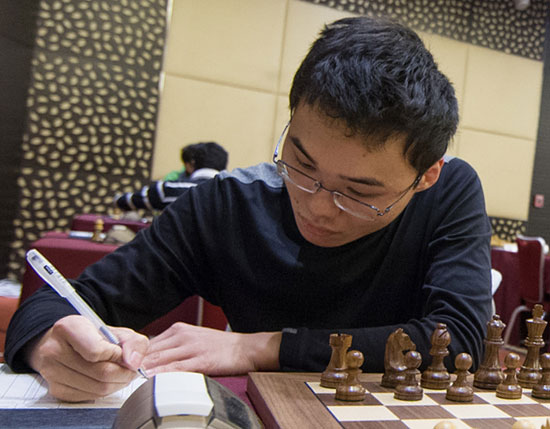
Yu Yangyi proved his class in this game. Strong opening preparation, purposeful play in the middlegame and loads of patience in the endgame gave him a crucial victory. After six straight wins, two losses have resulted in Giri being out of the title race. But for Yu Yangyi it's a big day tomorrow. He takes on Kramnik with the white pieces! If he mananges to beat him, he becomes the Qatar Masters Champion.
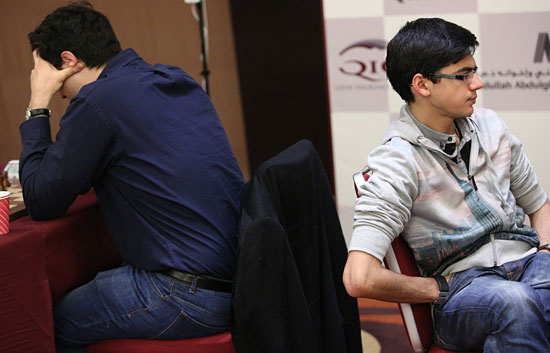
The two main rivals in this event, Vladimir Kramnik and Anish Giri, were playing back to back
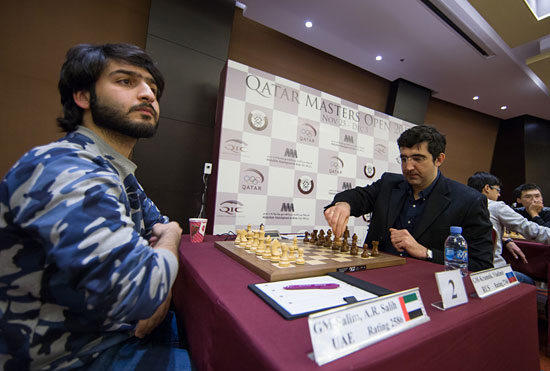
Salim Saleh vs Vladimir Kramnik, the decisive game – probably of the whole Qatar Masters 2014
If you want to learn the art of how to win equal endgame positions, this game is for you! Look at it carefully and learn from the Russian legend!

[Event "Qatar Masters Open 2014"] [Site "Doha QAT"] [Date "2014.12.03"] [Round "8.2"] [White "Salem, A.R. Saleh"] [Black "Kramnik, Vladimir"] [Result "0-1"] [ECO "D37"] [WhiteElo "2586"] [BlackElo "2760"] [Annotator "Sagar Shah"] [PlyCount "110"] [EventDate "2014.11.26"] 1. d4 Nf6 2. c4 e6 3. Nf3 d5 4. Nc3 Nbd7 {This is a small tweak in the opening. The main moves are of course Be7 and Bb4. With this move Nbd7, Black keeps the game in QGD territory but gets some additional options.} 5. Bg5 (5. Bf4 c6 6. e3 Nh5 {Though only tried in blitz by Carlsen and Kramnik, it is possible that Kramnik was intending to play this today.}) 5... h6 6. Bh4 Be7 7. e3 O-O 8. Rc1 c5 9. cxd5 Nxd5 10. Bxe7 Nxe7 {White should definitely be slightly better here. He has developed all his pieces logically. But what Kramnik really wants is an equal game from where he can try to outplay his opponent.} 11. Be2 b6 12. O-O Bb7 13. dxc5 Nxc5 14. Nd4 (14. Qxd8 Rfxd8 15. Rfd1 Nd5 16. Nxd5 Bxd5 17. b3 $11 {and in this symmetrical position I wonder how Kramnik would have won. But I am nowhere near the level of Kramnik's technique, so it's better that I do not get into it!}) 14... Nf5 $5 15. Nxf5 exf5 16. Bf3 $6 {I dislike this move. It might be objectively fine, but if White wanted to play safely then why not just exchange the queens and play Rfd1?} (16. Qxd8 Rfxd8 17. Rfd1 $11) 16... Qxd1 17. Rfxd1 Bxf3 18. gxf3 Rfd8 19. Kf1 {Bringing the king into the center is natural.} (19. Rxd8+ Rxd8 20. Rd1 Rxd1+ 21. Nxd1 {This position might not hold any advantage for Black, but it is a very timid decision of trying to exchange both the rooks and bringing your knight to an unfavourable square – something that Salem Saleh being an aggressive player would dislike.}) 19... g6 20. Ke2 Kg7 21. Nb5 Kf6 22. Rxd8 Rxd8 23. b4 (23. Nxa7 Ra8 {wins back the pawn. Here White had a very nice move though.} 24. Nc8 $5 Rxa2 (24... Rxc8 25. b4 Ra8 26. bxc5 Rxa2+ 27. Kf1 bxc5 28. Rxc5 $11 {and even the best technique in the world cannot win this.}) 25. Rc2 Ra6 26. Nxb6 Rxb6 27. Rxc5 $11) 23... Ne6 24. Rc6 (24. Nc7 Rd7 25. Nxe6 fxe6 $11) 24... Ke7 25. a3 Rd7 26. Rc8 a6 27. Nc3 b5 28. Ra8 Rd6 29. Rh8 g5 $1 (29... h5 {was also possible but the move g5 has a very deep idea behind it. As the game progresses you will get to find out why.} ) 30. Ra8 (30. Rxh6 $2 Nf4+ $19) 30... Kf6 $1 {[%csl Rh2][%cal Gf6g6,Gg6h5, Gh5h4,Gh4h3] Kramnik now starts a king march towards the weakest point in White's position. Any guesses? Of course the h2 pawn!} 31. Ra7 Kg6 32. Na2 Nd8 33. Ke1 $2 {Why to waste time. Better would have been Nc1-b3-c5.} Kh5 {As Lasker said,"It is better to follow out a plan consistently even if it isn't the best one than to play without a plan at all". Here Black has a clear-cut idea of attacking the h2 pawn while White is doing nothing much. That is the main reason why his position slowly goes downhill.} 34. Nc1 Kh4 35. Nb3 Kh3 36. Nd4 (36. Nc5 Kxh2 37. Rxa6 Rxa6 38. Nxa6 Kg2 $19 {and the h-pawn queens easily. }) 36... f4 37. Ra8 Kxh2 38. Nf5 Rf6 39. e4 (39. Nxh6 Rxh6 40. Rxd8 Kg2 {is a scary position, particularly because Ke2 doesn't work here.} 41. Ke2 g4 $1 42. fxg4 f3+ $19) 39... Nc6 40. Rxa6 Rg6 {You can bank on the fact that in this technical phase of the game, Kramnik will be the more accurate than most players in the world.} 41. Kf1 {Trying to lock the king on h2.} Ne5 42. Ra5 Nxf3 43. Rxb5 {It is a race between the pawns now but Black pawns supported by the king are way faster than the White pawns.} g4 (43... h5 {might have been more accurate way to start.}) 44. Rd5 (44. a4 g3 45. Nxg3 $1 Nd2+ 46. Ke2 fxg3 47. fxg3 Nxe4 48. Kf3 Nxg3 49. Rc5 $17 {White has some drawing chances because the black forces are not co-ordinated. But it should not be enough.}) 44... h5 45. Ng3 h4 (45... fxg3 46. Rxh5+ Nh4 47. Rxh4# {would be horrible!}) 46. Ne2 g3 47. fxg3 (47. Nxf4 g2+ 48. Nxg2 Rxg2 $19) 47... fxg3 48. b5 Rf6 49. Rf5 Rxf5 50. exf5 g2+ 51. Kf2 Nd4 52. Ng1 Nxb5 53. a4 Nc3 54. Nf3+ Kh1 55. a5 h3 (55... h3 56. a6 h2 $19) 0-1
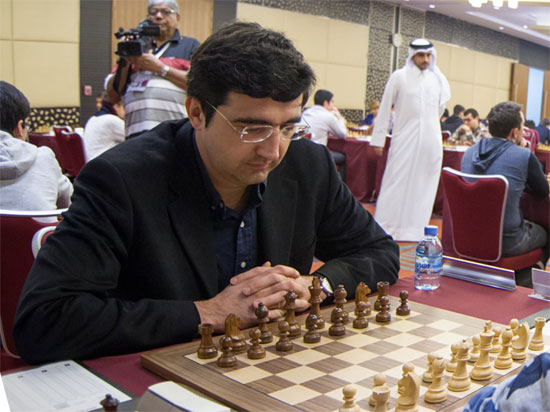
A fantastic technical achievement by Kramnik. The thing that I loved the most about this game was that even though Vladimir was in a must-win situation and he was facing an opponent who was rated 200 points below him yet he played very objectively. He didn't despise equal positions. He went into it and tried to find those little imbalances like the h2 pawn weakness which would help him win. Using all his technical superiority he ground out a win! And of course we must remember that Salem Saleh is best known for his attacking and uncompromising style of play. These quiet positions are not really his strength and hence he couldn't play them so well.
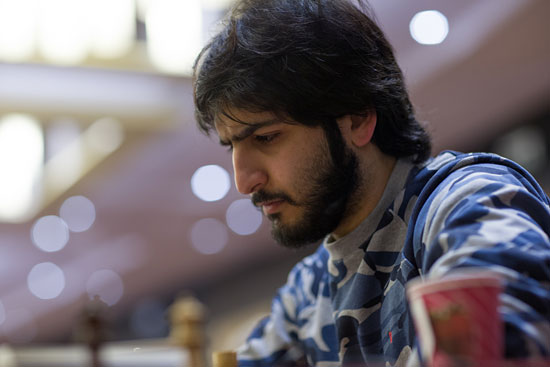
Top UAR GM Salem Saleh was playing the tournament of his life when he hit the roadblock Kramnik

[Event "St Petersburg"] [Site "St Petersburg"] [Date "1909.??.??"] [Round "?"] [White "Cohn, Erich"] [Black "Rubinstein, Akiba"] [Result "0-1"] [ECO "D21"] [Annotator "Sagar Shah"] [SetUp "1"] [FEN "8/pp2kppp/4p3/8/1Pr5/P3PP2/3K1P1P/R7 w - - 0 24"] [PlyCount "30"] [EventDate "1909.??.??"] [EventRounds "20"] [EventCountry "RUS"] [Source "ChessBase"] [SourceDate "1999.07.01"] {Do you think the king march towards the h2 pawn weakness was found by Kramnik over the board? I do not think so. Have a look at this extremely famous game by the endgame master Akiba Rubinstein in which he executes the same idea.} 24. Rc1 $2 {White should have maintained the rooks and would have been minimally worse.} Rxc1 $1 25. Kxc1 Kf6 $1 {[%csl Rh2][%cal Gf6g5,Gg5h4,Gh4h3] Akiba starts the attack on the h2-pawn, just like Kramnik did in his game with Salem. } 26. Kd2 Kg5 27. Ke2 Kh4 28. Kf1 Kh3 29. Kg1 {And now for the most powerful of pawn storms with minimal material on the board!} e5 30. Kh1 b5 31. Kg1 f5 32. Kh1 g5 33. Kg1 h5 {Garry Kasparov rightly noted in his My Great Predecessors that this position looks like a study!} 34. Kh1 g4 35. e4 (35. fxg4 fxg4 (35... hxg4 {is a little more complicated than fxg4 but also wins.} 36. Kg1 f4 37. exf4 exf4 38. Kh1 f3 $1 (38... g3 39. fxg3 fxg3 40. hxg3 Kxg3 41. Kg1 Kf3 42. Kf1 Ke3 43. Ke1 Kd3 44. Kd1 Kc3 45. a4 $1 $11) 39. Kg1 Kh4 40. Kf1 (40. Kh1 Kg5 41. h3 gxh3 42. Kh2 Kg4 43. Kg1 Kf4 44. Kh2 Ke4 45. Kxh3 Kd3 46. Kg4 Ke2 47. Kg3 a6) 40... Kh5 41. Ke1 Kg5 42. Kf1 Kf4 43. Ke1 Ke4 44. Kd2 Kd4 45. Kc2 Kc4 46. Kd2 Kb3 47. Ke3 Kxa3 48. Kf4 Kxb4 $19) 36. Kg1 e4 $19 { [%cal Gh5h4,Gg4g3]}) 35... fxe4 36. fxe4 h4 37. Kg1 g3 38. hxg3 hxg3 {A brilliant endgame display by Rubinstein. I am sure that Kramnik was motivated by this game when he embarked upon the king march. Such is the importance of knowing your classics. It can help you in the most varied of situations!} 0-1
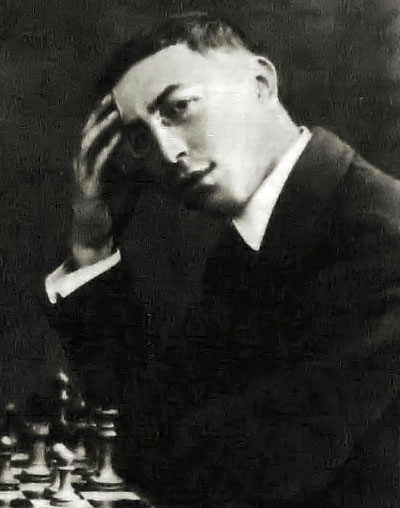
Been there, done that: Akiba Rubinstein, Polish GM (1880–1961)
Impressions from round eight by Vijay Kumar
Top standings after eight rounds
Standings and results of all 150 players here
Top pairings for the final round
Links
